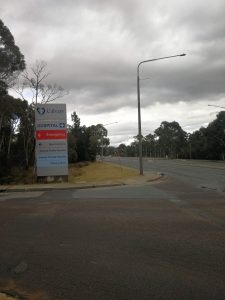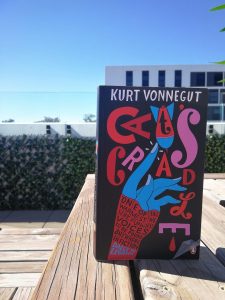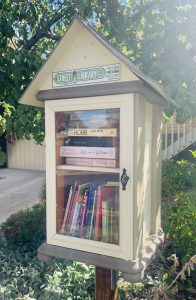Don’t Underestimate Louise
By Kalindi Commerford
Have you ever thought of your skin as a coffin? Death is an inevitable fact of life for all of us, however what if you were considered lifeless or ‘vegetative’ while still alive? It’s a state that can baffle doctors causing them to move treatment plans away from recovery towards asking our spiritual leaders for a miracle. This essentially is dancing a fine line between hope and hopelessness.
At the age of 21 Louise Ellery was stuck in this reality. She was involved in a car crash that left her in a coma for five months and resulted in her becoming a quadriplegic. I’m sure for most people looking in from the outside, being a quadriplegic is a grim thought. Things could have been much worse for Louise though. She could be dead. Or, as her doctors expected, she could have stayed in a vegetative state.
The prospect of this is quite depressing. What happened to Louise is horrific. However I wouldn’t describe it as a total tragedy. Louise’s life as it stands now is not tragic in fact it’s quite accomplished. She is a quick-witted woman who projects happiness through her emphatic smile and her gleaming blue-eyed gaze.
As her mother would say “don’t underestimate Louise”. This motto has seen Louise beat the odds and many competitors. Louise is a successful athlete, a world record holder, a qualified businesswoman, and most recently has written and produced her own short film. All of this perhaps would not have been possible if it wasn’t for extensive rehabilitation, and tremendous will power coupled with some street smarts from her mother June.
When you read a newspaper story in its completion that’s where the story ends. When Louise’s crash was part of the news it read as hard news does. Factual. For Louise however that’s where her story began.
Survival
Louise had her accident in Brisbane where she remained in a coma for five months. While in Brisbane June received Dr Ted Freeman’s book ‘The Catastrophe of Coma- A Way Back’ from a friend whose husband was in a coma and had become quadriplegic. The book is a guide for loved ones on how to deal with brain injuries, things you can do to help the patient, while offering you as a reader comfort.
Louise was flown to Canberra in a non-responsive state. At the time she was in a fixed position. In Brisbane doctors and allied health professionals worked on her, putting her on tilt tables and in splints. Her hands were clenched and she was splinted to try and release her contracting muscles. When she arrived in Canberra June had pitched a splinting timetable up in Louise’s hospital room. There are real feelings of gratitude towards the hospitals, “the hospital were really good to us”.
June became part of the furniture at the hospital. Always present and always doing things to stimulate Louise, physically and mentally. Her father, Graham also visited her daily. This was important as “being there showed (the hospital staff) somebody cared”. One day Louise’s dog Sachi was bought into hospital and “she just stared right through him”
There was a point where the physiotherapist prescribed a maintenance program. June questioned why this wasn’t a progressive program. It seemed people were giving up quickly, “ready to dismiss her too quickly”. Reminder: “don’t underestimate Louise”. One of the biggest hurdles in Louise’s life has been overcoming the traditional western medical coma treatment. Doctors advised June to move her into a nursing home at the age of 21. This was not a notion her parents were prepared to accept.
At five months June contacted Dr Freeman.
Freeman Files
June asked the neurosurgeon if Louise could see Dr Freeman, the answer was a flat out no. The hospital didn’t agree with Dr Freeman’s philosophies, banning him from the hospital. Dr Freeman worked through a protocol that he developed called coma arousal therapy, in an attempt to ‘unlock patients’. At the time Dr Freeman was working at the National Brain Injury Foundation (NBIF) in Hughes, Canberra.
Because of the hospital’s opposition to Louise seeing Dr Freeman June had to go into stealth mode. She snuck Louise out of hospital twice. It wasn’t as inconspicuous as what I’ve made it seem though, Louise was in a hospital chair that can be likened to a La-Z-Boy on wheels.
The first escape was disguised as a typical stroll, not an uncommon activity for the pair. They met Dr Freeman in Garran Primary School’s car park. Louise and Dr Freeman made eye contact upon introduction, a prominent sign of making conscious contact. “As soon as I saw her I knew she wasn’t vegetative”. He spoke gently and with a lot of respect, assuming she could hear him.
The second meeting had a little more risk. Dr Freeman wanted Louise to go to NBIF. “She’s not allowed out”.
“We will bring the van”.
June, full of anxious jitters, walked Louise straight out the hospital and into the van. Though the hospital never found out, the risk of getting caught could have meant dismissal from the hospital, resulting in moving Louise to a nursing home or into the family home, which was not equipped to provide the care Louise needed. The bathroom was eventually gutted and remodelled, and hoists were implemented to lift her around the house “I guess like a potato”. June did not want to lose the support of the hospital.
Louise’s memory of this time is minimal. She does have one vivid memory however of a friend reading her a story. She hated the story, and she hated the sound of the voice. This is a typical blunt comical response you might expect to receive from Louise.
Nonetheless a rehab plan was created. Slowly and gradually Louise started making improvements. At nine months Louise was taken home. Dr Freeman visited the home and had Louise crawling. You crawl before you walk after all. Louise found this degrading. They also worked with parallel bars, learning how to stand against walls and let go.
The first noticeable response June got from Louise was when she was stretching her hamstring. It’s not something anyone can really say they enjoy, so it’s no surprise Louise was squirming. “If you don’t like it all you have to say is no”.
Louise replied with a groan “no-oo-oo”.
Whilst improvements were slow and gradual they definitely did not stop here. They have improved so much that Louise now has a trophy case full of national and international sporting achievements.
The World Stage
Louise has always been athletic. Growing up she dabbled in swimming, water polo, basketball, hockey, softball, and the list goes on.
One of the first sports Louise tried in 2001/2002 after the accident was wheelchair basketball. This didn’t take though; she was often turning in circles. Her coach saw the frustration and suggested she go to the AIS where there was a disability program for kids ran under Chris Timpson. This is where Louise and shot put met for the first time.
In 2003 Louise went to her first nationals. At one of her first meets in Sydney Louise felt as though the officials were treating her as disabled. This is not a label she liked or chose to associate with. She starting screaming, “I’m not fucking disabled”. At this stage in her recovery Louise’s speech wasn’t overly clear, and her mother June was one of the only people who understood the abuse coming from her daughters mouth. Fair enough though.
Shot put started out as a social thing. It then started giving Louise self esteem boosts and something to focus on. “It kept my body moving … it gives me an opportunity to show everyone I’m not effing disabled”.
There was an outside chance to qualify for the Paralympics if she threw five metres. True to form, she did this, and in 2004 she was headed to the Paralympics in Athens.
The moment Louise was named in the Athens team will always remain particularly special to her because her brother Robert was there with her. Two weeks before Athens he was killed in a car crash. Louise then had to stay in the village away from family. She managed to place “sixth out of the world”.
2005 rolled around and Louise continued to train and refine her techniques. This involved occasionally throwing the shot put with her eyes shut to really feel the movements. It’s a technique used to practice the sensory pattern and tattoo it into the brain. At nationals in Sydney Louise decided she would throw the way she was practicing. She literally broke the world record with her eyes shut. “Don’t underestimate Louise”. Since, she has been the world record holder on and off.
“I had a magic year in 2010. I was the first person in my class to beat the six-meter mark. I kept bettering it and won gold in Delhi (Commonwealth Games) with a world record (6.17 metres)”.
She has bettered this throw since. In Christchurch at the IPC Athletics World Championship she threw 6.31 meters. The world caught up to Louise at this meet, with everyone who placed beating world records as they then stood. She came home with the bronze and even more incentive to keep training.
2016 is a big year for most athletes around the world. The Rio de Janeiro Olympics games will take place in August. The team will be announced in June/July. Louise “still has to show the world” that she’s the best in the business. From now until then she wants to remain on an upward trajectory, aiming to peak in Rio.
To make sure she comes home with the gold around her neck she has been training a lot harder. She is stronger now than she’s ever been, and it goes without saying that this strength will continue to grow up until the point where she decides to retire.
Perhaps one of the biggest competitors at the moment for Louise is a young Tunisian girl that’s streaking ahead. I don’t think a lot of Louise’s attention is really paid to “all these young grommets” though.
Louise doesn’t have much to say to her competitors “except maybe good luck, throw well … well not further than me, and they’ll all be comfortable whilst I work my butt off, floating like a butterfly and come Rio time, I’ll be peaking, and BOOM sting like a Brazilian Bee!”
Louise plans on retiring when she has a partner to settle down with and some of her own grommets running around. When she was in hospital there was a wardsman called Michael, “he was dreamy”. He was soon renamed Marry-Me-Michael.
As it stands her current training regime sees her train six or seven days a week. She has two gym sessions at the ACT Academy of Sport, three field sessions where she’s throwing the shot put, and she’s in the pool three times a week. It’s hard to imagine this woman has much time to do anything else. To think in such a way would be to underestimate Louise. She is definitely not married to her sport.
Away from the Field
There are plenty of goals being kicked off the field. Most recently she has been listed on the 2016 Who’s Who of Australian Woman list. This list celebrates the achievements of Australia’s most prominent women.
Louise has also written and produced her own short film, ‘With Little Hope’. The movie is basically about her life. “I think there is a message in there never to give up, if people just persist and keep working, perseverance, never give up on your dreams”. The premier date has not yet been locked in.
There’s plenty more to come though. “With Little Hope is a short film, it’s going to be fantastic, you’ll have to wait for the feature film after, and they’ll rise, rise, rise and never stop until the day I stop, but I just keep going”. Louise has aspirations of becoming a world-renowned screenwriter. She has important messages from her life, and I’m sure if she hasn’t already, her message will continue to teach and inspire.
This is a slice of the story of Louise that unfolded after the news stopped reporting about the accident. Headlines that once read of trauma now read of triumph.
“Don’t underestimate Louise”.




Be the first to comment!